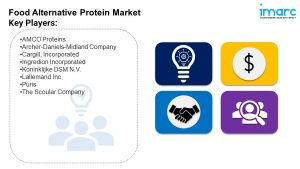Summary:
- The global food alternative protein market size reached USD 19.8 Billion in 2023.
- The market is expected to reach USD 52.3 Billion by 2032, exhibiting a growth rate (CAGR) of 11.1% during 2024-2032.
- North America leads the market, accounting for the largest food alternative protein market share.
- Plant-based protein accounts for the majority of the market share in the source segment due to its wide consumer appeal and the rising demand for sustainable, plant-based diets.
- Meat analogs hold the largest share in the food alternative protein industry.
- The increasing consumer demand for plant-based proteins is a primary driver of the food alternative protein market.
- The advancement in cultivated meat technology is propelling the food alternative protein market.
Industry Trends and Drivers:
- Growing Consumer Demand for Plant-Based Proteins:
The demand for plant-based proteins is accelerating as consumers become more health-conscious and environmentally aware. Products made from soy, pea, and other plant-based sources are gaining popularity due to their sustainability and nutritional benefits. These alternatives offer similar protein content to animal-based products without the environmental impact associated with livestock farming. In addition, innovations in flavor and texture have made plant-based proteins more appealing to a wider audience. Companies are focusing on creating meat substitutes that closely resemble the taste and texture of real meat, further driving consumer interest. The plant-based protein sector is expected to expand rapidly, driven by changing dietary preferences and growing concerns over climate change and animal welfare.
- Technological Advancements:
Cultivated meat, also known as lab-grown or cell-based meat, is a rapidly developing segment of the alternative protein market. This technology involves growing animal cells in controlled environments, producing meat without the need for raising and slaughtering livestock. Advancements in biotechnology, such as precision fermentation and cell-based meat production, are enabling the development of high-quality protein alternatives that closely mimic the taste, texture, and nutritional content of traditional meat products. These innovations are making alternative proteins more appealing to mainstream consumers who are not willing to compromise on taste or quality. . While still in its early stages, the sector has received significant investment and interest from major food companies and startups. As regulatory approvals advance, cultivated meat could revolutionize the food industry by providing a sustainable, ethical alternative to traditional meat production, appealing to environmentally conscious consumers and those looking for innovative food options.
- Growing Awareness About Insect Protein:
Insect protein is emerging as a promising alternative in the protein market, particularly in regions where insects are already part of the traditional diet. Insects like crickets, mealworms, and grasshoppers offer a highly sustainable source of protein with a smaller environmental footprint than traditional livestock farming. They require fewer resources such as land, water, and feed, while emitting lower greenhouse gases. Insect protein is also rich in essential nutrients, making it an attractive option for food manufacturers looking to create nutrient-dense products. Although insect protein faces some cultural resistance in Western markets, it is gradually gaining acceptance as awareness of its sustainability benefits grows. Efforts to integrate insect protein into more familiar food formats, like protein bars or flour, are expected to drive its market growth.
Request Sample For PDF Report: https://www.imarcgroup.com/food-alternative-protein-market/requestsample
Report Segmentation:
The report has segmented the market into the following categories:
Breakup by Source:
- Plant-based
- Insect-based
- Microbial-based
- Bacteria
- Yeast
- Algae
- Others
Plant-based protein accounts for the majority of shares due to its broad consumer acceptance and the growing demand for sustainable, plant-based diets.
Breakup by Application:
- Meat Analogs
- Bakery
- Dairy Alternatives
- Cereals and Snacks
- Beverages
- Others
Meat analogs exhibit a clear dominance as they provide a familiar alternative to traditional meat products, appealing to consumers seeking similar taste and texture.
Market Breakup by Region:
- North America (United States, Canada)
- Asia Pacific (China, Japan, India, South Korea, Australia, Indonesia, Others)
- Europe (Germany, France, United Kingdom, Italy, Spain, Russia, Others)
- Latin America (Brazil, Mexico, Others)
- Middle East and Africa
North America holds the leading position owing to its early adoption of alternative proteins, strong investment in innovation, and increasing consumer interest in health and sustainability.
Competitive Landscape with Key Player:
- AMCO Proteins
- Archer-Daniels-Midland Company
- Cargill, Incorporated
- Ingredion Incorporated
- Koninklijke DSM N.V.
- Lallemand Inc.
- Puris
- The Scoular Company

Note: If you need specific information that is not currently within the scope of the report, we will provide it to you as a part of the customization.
About Us
IMARC Group is a global management consulting firm that helps the world’s most ambitious changemakers to create a lasting impact. The company provide a comprehensive suite of market entry and expansion services. IMARC offerings include thorough market assessment, feasibility studies, company incorporation assistance, factory setup support, regulatory approvals and licensing navigation, branding, marketing and sales strategies, competitive landscape and benchmarking analyses, pricing and cost research, and procurement research.
